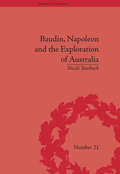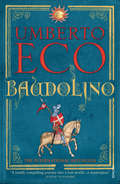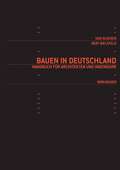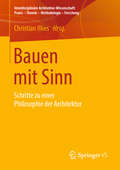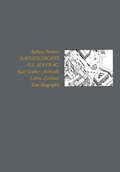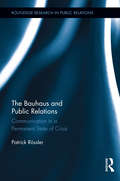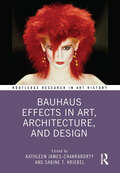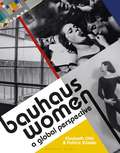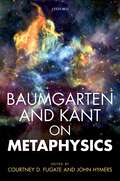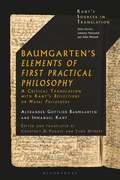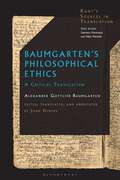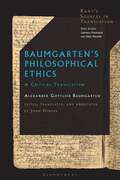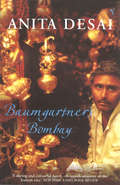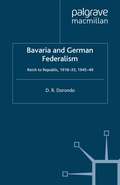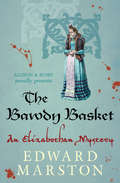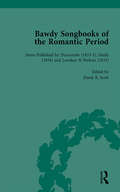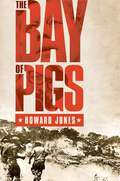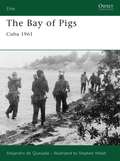- Table View
- List View
Baudin, Napoleon and the Exploration of Australia (Empires in Perspective #21)
by Nicole StarbuckThis is the first in-depth study of the sojourn in Sydney made by Nicolas Baudin’s scientific expedition to Australia in 1802. Starbuck focuses on the reconstruction of the voyage during the expedition’s stay in colonial Sydney and how this sheds new light on our understanding of French society, politics and science in the era of Bonaparte.
Baudolino (Booket/columna Ser. #Vol. 28)
by Umberto EcoAn extraordinary epic, brilliantly-imagined, new novel from a world-class writer and author of The Name of the Rose. Discover the Middle Ages with Baudolino - a wondrous, dazzling, beguiling tale of history, myth and invention. It is 1204, and Constantinople is being sacked and burned by the knights of the fourth Crusade. Amid the carnage and confusion Baudolino saves a Byzantine historian and high court official from certain death at the hands of the crusading warriors, and proceeds to tell his own fantastical story.
Bauen in Deutschland: Handbuch für Architekten und Ingenieure (Bauen in Europa (u.China))
by Udo Blecken Bert BielefeldDieses Handbuch bietet einen strukturierten Überblick über die Arbeit von Architekten und Ingenieuren in Deutschland: von der Auftragsbeschaffung, über die Planung, bis hin zur Bauausführung und Bauabnahme. Durch die anschauliche Vermittlung des rechtlichen und wirtschaftlichen Umfelds sowie praktischer Hilfestellung stellt "Bauen in Deutschland" eine wertvolle Unterstützung des Berufsalltags dar.
Bauen mit Sinn: Schritte zu einer Philosophie der Architektur (Interdisziplinäre Architektur-Wissenschaft: Praxis – Theorie – Methodologie – Forschung)
by Christian IlliesArchitektur ist mehr als die technisch-funktionale Lösung eines praktischen Problems. In Bauwerken drückt sich immer auch ein Weltverhältnis aus - und macht zugleich ein bleibendes Sinn-Angebot. Architektur ist deswegen ein Anstoß, manchmal auch ein Apell, über sehr unterschiedliche Fragen nachzudenken, sich zu ihnen zu verhalten und sich dabei geistig zu verorten.In diesem Buch begegnen sich eine Vielfalt der Deutungs- und Annäherungsmöglichkeiten durch Vertreter unterschiedlicher Kultur- und Geisteswissenschaften. Die Eigenart der Wahrnehmungen und unterschiedlichen methodischen Herangehensweisen kommen so in ein Gespräch. Es soll zu einem besseres Verstehen, aber auch Bewerten führen. Denn wenn Bauwerke Sinn-Angebote machen, lassen sich diese auch beurteilen, da sie Ideale und mögliche Lebensweisen ausdrücken machen, die nicht alle gleichwertig sind. Der InhaltSchritte zu einer Philosophie der Architektur · Die Struktur des Raumes und die urbane Gemeinschaft · Das ‚Architektonische‘· Zur Aufgabe einer Philosophie des Bauwerks · Geometrische Muster zwischen frühneuzeitlicher Utopie und russischer Avantgarde · Moderne oder historisierende Architektur in der alten Stadt · Die Architektur des Heiligen · Meta Sudans, oder: Akustik und Geruch im antiken Rom -· Die Verallgemeinerung des Besonderen. Die Dresdner Frauenkirche und der gegenwärtige Rekonstruktionsfuror · Die Architektur der Schöpferischen Zerstörung · Architektur und Bild · Stadtbaukunst · Was ist gute Architektur? · Über Wahrheit und Lüge im architektonischen Sinn · Rekonstruktion in historischer und aktueller Perspektive · Wie gefährlich sind Rekonstruktionen? · Wie sollen wir bauen?Der HerausgeberDr. Christian Illies ist Professor für Philosophie an der Universität Bamberg.
Baugeschichte als Auftrag: Karl Gruber: Architekt, Lehrer, Zeichner Eine Biographie
by Andreas RomeroThe Bauhaus and Public Relations: Communication in a Permanent State of Crisis (Routledge Research in Public Relations)
by Patrick RösslerThis innovative study considers one of the most important art and design movements of the 20th century, the Bauhaus, in conjunction with current research in public relations and organizational communication, elaborating on the mechanisms of internal and external communication available to influence the stakeholders in politics, society, industry, and the art world. In a movement where a substantial share of productivity ran in measures to highlight the public value of the institution funded by the taxpayer, the directors, and other persons in charge, the Bauhaus developed comprehensive strategies to communicate their messages to a variety of target groups such as politicians and economic leaders, intellectuals and other artists, current and prospective students, and the general public. To achieve this goal, the Bauhaus anticipated many instruments of modern public relations and corporate communications, including press releases, staging of events, media publications, community building, lobbying, and the creation of nationwide public presence. Rössler argues that as an organization, the Bauhaus cultivated corporate behavior and, most prominently, a corporate design which unfolded revolutionary power. The basic achievements of new typography (a label coined at the Bauhaus) determine visual communication to this day, while the Bauhaus moved from an institutional organization to a community. Beginning with an overview of the Bauhaus’ corporate identity and a close examination of the respective directors’ roles for internal and external communication, this book visits exhibitions, events, and the media attention they evoked in newspapers and contemporary periodicals, along with media products designed at the Bauhaus such as magazines, books, and bank notes.
The Bauhaus and Public Relations: Communication in a Permanent State of Crisis (Routledge Research in Public Relations)
by Patrick RösslerThis innovative study considers one of the most important art and design movements of the 20th century, the Bauhaus, in conjunction with current research in public relations and organizational communication, elaborating on the mechanisms of internal and external communication available to influence the stakeholders in politics, society, industry, and the art world. In a movement where a substantial share of productivity ran in measures to highlight the public value of the institution funded by the taxpayer, the directors, and other persons in charge, the Bauhaus developed comprehensive strategies to communicate their messages to a variety of target groups such as politicians and economic leaders, intellectuals and other artists, current and prospective students, and the general public. To achieve this goal, the Bauhaus anticipated many instruments of modern public relations and corporate communications, including press releases, staging of events, media publications, community building, lobbying, and the creation of nationwide public presence. Rössler argues that as an organization, the Bauhaus cultivated corporate behavior and, most prominently, a corporate design which unfolded revolutionary power. The basic achievements of new typography (a label coined at the Bauhaus) determine visual communication to this day, while the Bauhaus moved from an institutional organization to a community. Beginning with an overview of the Bauhaus’ corporate identity and a close examination of the respective directors’ roles for internal and external communication, this book visits exhibitions, events, and the media attention they evoked in newspapers and contemporary periodicals, along with media products designed at the Bauhaus such as magazines, books, and bank notes.
Bauhaus Effects in Art, Architecture, and Design (Routledge Research in Art History)
by Kathleen James-ChakrabortyBringing together an international team of scholars, this book offers new perspectives on the impact that the Bauhaus and its teaching had on a wide range of artistic practices. Three of the fields in which the Bauhaus generated immediately transformative effects were housing, typography, and photography. Contributors go further to chart the surprising relation of the school to contemporary developments in hairstyling and shop window display in unprecedented detail. New scholarship has detailed the degree to which Bauhaus faculty and students set off around the world, but it has seldom paid attention to its impact in communist East Germany or in countries like Ireland where no Bauhäusler settled. This wide-ranging collection makes clear that a century after its founding, many new stories remain to be told about the influence of the twentieth century’s most innovative arts institution. The book will be of interest to scholars working in art history, design history, photography, and architectural history.
Bauhaus Effects in Art, Architecture, and Design (Routledge Research in Art History)
by Kathleen James-Chakraborty Sabine T. KriebelBringing together an international team of scholars, this book offers new perspectives on the impact that the Bauhaus and its teaching had on a wide range of artistic practices. Three of the fields in which the Bauhaus generated immediately transformative effects were housing, typography, and photography. Contributors go further to chart the surprising relation of the school to contemporary developments in hairstyling and shop window display in unprecedented detail. New scholarship has detailed the degree to which Bauhaus faculty and students set off around the world, but it has seldom paid attention to its impact in communist East Germany or in countries like Ireland where no Bauhäusler settled. This wide-ranging collection makes clear that a century after its founding, many new stories remain to be told about the influence of the twentieth century’s most innovative arts institution. The book will be of interest to scholars working in art history, design history, photography, and architectural history.
Bauhaus Women: A Global Perspective
by Elizabeth Otto RösslerForty five key women of the Bauhaus movement.Bauhaus Women: A Global Perspective reclaims the other half of Bauhaus history, yielding a new understanding of the radical experiments in art and life undertaken at the Bauhaus and the innovations that continue to resonate with viewers around the world today. The story of the Bauhaus has usually been kept narrow, localized to its original time and place and associated with only a few famous men such as Walter Gropius, Marcel Breuer, Paul Klee, Wassily Kandinsky, and László Moholy-Nagy. Bauhaus Women: A Global Perspective bursts the bounds of this slim history by revealing fresh Bauhaus faces: Forty-five Bauhaus women unjustifiably forgotten by most history books. This book also widens the lens to reveal how the Bauhaus drew women from many parts of Europe and beyond, and how, through these cosmopolitan female designers, artists, and architects, it sent the Bauhaus message out into the world and to a global audience.
Bauhaus Women: A Global Perspective
by Elizabeth Otto RösslerForty five key women of the Bauhaus movement.Bauhaus Women: A Global Perspective reclaims the other half of Bauhaus history, yielding a new understanding of the radical experiments in art and life undertaken at the Bauhaus and the innovations that continue to resonate with viewers around the world today. The story of the Bauhaus has usually been kept narrow, localized to its original time and place and associated with only a few famous men such as Walter Gropius, Marcel Breuer, Paul Klee, Wassily Kandinsky, and László Moholy-Nagy. Bauhaus Women: A Global Perspective bursts the bounds of this slim history by revealing fresh Bauhaus faces: Forty-five Bauhaus women unjustifiably forgotten by most history books. This book also widens the lens to reveal how the Bauhaus drew women from many parts of Europe and beyond, and how, through these cosmopolitan female designers, artists, and architects, it sent the Bauhaus message out into the world and to a global audience.
Baumgarten and Kant on Metaphysics
by John Hymers Courtney D. FugateBaumgarten and Kant on Metaphysics explores the metaphysics of Alexander Gottlieb Baumgarten (17141762) and its decisive influence on Immanuel Kant. For over a century, scholars have recognized the significance of Baumgarten's Metaphysics, both because of its impact on Kant's intellectual development, and because of the way it fundamentally informed the work of generations of German philosophers, including Moses Mendelssohn, Thomas Abbt, Johann Gottfried Herder, Solomon Maimon, Johann August Eberhard, and arguably even Georg Friedrich Hegel. However, Baumgarten's Metaphysics has only recently become available in reliable German and English translations; as such, many scholars have been excluded from the discussion and the significance of Baumgarten's work has remained largely unexplored. Thus with the appearance of these translations, interest in Baumgarten's work has surged. This collection provides an anchor for this emerging discussion by presenting chapters by some of the scholars most responsible for Baumgarten's current reputation, together with some of the best young scholars in this emerging field.
Baumgarten and Kant on Metaphysics
Baumgarten and Kant on Metaphysics explores the metaphysics of Alexander Gottlieb Baumgarten (17141762) and its decisive influence on Immanuel Kant. For over a century, scholars have recognized the significance of Baumgarten's Metaphysics, both because of its impact on Kant's intellectual development, and because of the way it fundamentally informed the work of generations of German philosophers, including Moses Mendelssohn, Thomas Abbt, Johann Gottfried Herder, Solomon Maimon, Johann August Eberhard, and arguably even Georg Friedrich Hegel. However, Baumgarten's Metaphysics has only recently become available in reliable German and English translations; as such, many scholars have been excluded from the discussion and the significance of Baumgarten's work has remained largely unexplored. Thus with the appearance of these translations, interest in Baumgarten's work has surged. This collection provides an anchor for this emerging discussion by presenting chapters by some of the scholars most responsible for Baumgarten's current reputation, together with some of the best young scholars in this emerging field.
Baumgarten's Elements of First Practical Philosophy: A Critical Translation with Kant's Reflections on Moral Philosophy (Kant’s Sources in Translation)
by Alexander Gottlieb Baumgarten Immanuel KantThis book presents the first English translation of Alexander Baumgarten's Initia Philosophiae Practicae Primae, the textbook Kant used in his lectures on moral philosophy. Originally published in Latin in 1760, the Initia contains a systematic, but original version of the universal practical philosophy first articulated by Christian Wolff. In his personal copy, Kant penned hundreds of pages of notes and sketches that document his relation to this earlier tradition. Translating these extensive elucidations into English, together with Kant's notes on the text, this translation offers a complete resource to Kant's reading of the Initia. To facilitate further study, first-time translations of elucidatory passages from G. F. Meier and Wolff are also included, alongside a German-English-Latin glossary. The translators' introduction provides a biography of Baumgarten, a discussion of the importance of the Initia, its relation to Wolff's and Meier's universal practical philosophy and its role in Kant's lectures. By shedding new light on the arguments of Kant's mature works and offering insights into his pre-Critical moral thought, Elements of First Practical Philosophy reveals why Baumgarten's work is essential for understanding the background to Kant's philosophy.
Baumgarten's Elements of First Practical Philosophy: A Critical Translation with Kant's Reflections on Moral Philosophy (Kant’s Sources in Translation)
by Alexander Gottlieb Baumgarten Immanuel KantThis book presents the first English translation of Alexander Baumgarten's Initia Philosophiae Practicae Primae, the textbook Kant used in his lectures on moral philosophy. Originally published in Latin in 1760, the Initia contains a systematic, but original version of the universal practical philosophy first articulated by Christian Wolff. In his personal copy, Kant penned hundreds of pages of notes and sketches that document his relation to this earlier tradition. Translating these extensive elucidations into English, together with Kant's notes on the text, this translation offers a complete resource to Kant's reading of the Initia. To facilitate further study, first-time translations of elucidatory passages from G. F. Meier and Wolff are also included, alongside a German-English-Latin glossary. The translators' introduction provides a biography of Baumgarten, a discussion of the importance of the Initia, its relation to Wolff's and Meier's universal practical philosophy and its role in Kant's lectures. By shedding new light on the arguments of Kant's mature works and offering insights into his pre-Critical moral thought, Elements of First Practical Philosophy reveals why Baumgarten's work is essential for understanding the background to Kant's philosophy.
Baumgarten’s Philosophical Ethics: A Critical Translation (Kant’s Sources in Translation)
by Alexander Gottlieb BaumgartenAlexander Baumgarten's Ethica Philosophica (1740) served as a chief textbook of philosophical instruction in German universities for several decades, and was used by Immanuel Kant for his lectures on moral philosophy between 1759 and 1794. Now translated into English for the first time, John Hymers explores the extent of Baumgarten's influence on the development of German philosophy. Accompanied by an introduction to Baumgarten and his work, this translation features an explanation of the main themes of the Ethica Philosophica, touching upon its relation to Christian Wolff and G.F. Meier's practical philosophy, but focusing especially on its role in Kant's lectures. First-time translations of elucidatory passages from the writings of Meier, Wolff, and Heinrich Köhler appear together with the relevant transcriptions of Kant's lectures on ethics. Based on a thorough knowledge of the original text, Hymers' clear translation and supporting material makes it possible to distinguish Kant's own remarks and insights from his attempts to expound and summarize Baumgarten's ideas. This is a much-needed contribution for anyone working in the history of modern philosophy.
Baumgarten’s Philosophical Ethics: A Critical Translation (Kant’s Sources in Translation)
by Alexander Gottlieb BaumgartenAlexander Baumgarten's Ethica Philosophica (1740) served as a chief textbook of philosophical instruction in German universities for several decades, and was used by Immanuel Kant for his lectures on moral philosophy between 1759 and 1794. Now translated into English for the first time, John Hymers explores the extent of Baumgarten's influence on the development of German philosophy. Accompanied by an introduction to Baumgarten and his work, this translation features an explanation of the main themes of the Ethica Philosophica, touching upon its relation to Christian Wolff and G.F. Meier's practical philosophy, but focusing especially on its role in Kant's lectures. First-time translations of elucidatory passages from the writings of Meier, Wolff, and Heinrich Köhler appear together with the relevant transcriptions of Kant's lectures on ethics. Based on a thorough knowledge of the original text, Hymers' clear translation and supporting material makes it possible to distinguish Kant's own remarks and insights from his attempts to expound and summarize Baumgarten's ideas. This is a much-needed contribution for anyone working in the history of modern philosophy.
Baumgartner's Bombay
by Anita DesaiA perceptive observation about the human race cleverly constructed and told with Desai's opulent vocabulary.
Bavaria and German Federalism: Reich to Republic, 1918-33, 1945-49 (St Antony's Series)
by D. DorondoBavaria and German Federalism details the struggle by successive Bavarian political parties of the pre- and post-Nazi period to shape the construction of the German state in a decentralized fashion. While the Bavarian Peoples Party ultimately failed to redraw the Weimar constitution to satisfy Bavarian particularist desires, the Christian Social Union assumed the federalist mantle after 1945 and largely succeeded in helping shape western Germany into a workable federal state.
The Bawdy Basket: A Nicolas Bracewell Novel (Nicholas Bracewell #12)
by Edward Marston‘You’ve killed before, I fancy,’ he said.‘It’s my trade.’Theatre troupe Westfield’s Men take on a new actor, Francis Quilter, after reaching new heights of success. But with the new member, brings new trouble. Quilter’s father, Gerard, is on trial for the murder of an enemy, but he denies the charge and Nicholas Bracewell sets about proving his innocence.However, Bracewell’s loyalty to Francis drives a wedge between the players. Who will clear the Quilter family name? On their quest for the truth, they stumble across an unlikely ally, who may just hold the answers they’re looking for.
Bawdy Songbooks of the Romantic Period, Volume 4
by Patrick Spedding Paul Watt Ed Cray David Gregory Derek B ScottThe songbooks of the 1830-40s were printed in tiny numbers, and small format so they could be hidden in a pocket, passed round or thrown away.Collectors have sought ‘these priceless chapbooks’, but only recently a collection of 49 songbooks has come to light. This collection represents almost all of the known songbooks from the period.
Bawdy Songbooks of the Romantic Period, Volume 4
by Patrick Spedding Paul Watt Ed Cray David Gregory Derek B ScottThe songbooks of the 1830-40s were printed in tiny numbers, and small format so they could be hidden in a pocket, passed round or thrown away.Collectors have sought ‘these priceless chapbooks’, but only recently a collection of 49 songbooks has come to light. This collection represents almost all of the known songbooks from the period.
The Bay of Pigs (Pivotal Moments in American History)
by Howard JonesIn The Bay of Pigs, Howard Jones provides a concise, incisive, and dramatic account of the disastrous attempt to overthrow Castro in April 1961. Drawing on recently declassified CIA documents, Jones deftly examines the train of missteps and self-deceptions that led to the invasion of U.S.-trained exiles at the Bay of Pigs. Ignoring warnings from the ambassador to Cuba, the Eisenhower administration put in motion an operation that proved nearly unstoppable even after the inauguration of John F. Kennedy. The CIA and Pentagon, meanwhile, both voiced confidence in the outcome of the invasion, especially after coordinating previous successful coups in Guatemala and Iran. And so the Kennedy administration launched the exile force toward its doom in Cochinos Bay on April 17, 1961. Jones gives a riveting account of the battle--and the confusion in the White House--before moving on to explore its implications. The Bay of Pigs, he writes, set the course of Kennedy's foreign policy. It was a humiliation for the administration that fueled fears of Communist domination and pushed Kennedy toward a hardline "cold warrior" stance. But at the same time, the failed attack left him deeply skeptical of CIA and military advisers and influenced his later actions during the Cuban missile crisis.
The Bay of Pigs (Pivotal Moments in American History)
by Howard JonesIn The Bay of Pigs, Howard Jones provides a concise, incisive, and dramatic account of the disastrous attempt to overthrow Castro in April 1961. Drawing on recently declassified CIA documents, Jones deftly examines the train of missteps and self-deceptions that led to the invasion of U.S.-trained exiles at the Bay of Pigs. Ignoring warnings from the ambassador to Cuba, the Eisenhower administration put in motion an operation that proved nearly unstoppable even after the inauguration of John F. Kennedy. The CIA and Pentagon, meanwhile, both voiced confidence in the outcome of the invasion, especially after coordinating previous successful coups in Guatemala and Iran. And so the Kennedy administration launched the exile force toward its doom in Cochinos Bay on April 17, 1961. Jones gives a riveting account of the battle--and the confusion in the White House--before moving on to explore its implications. The Bay of Pigs, he writes, set the course of Kennedy's foreign policy. It was a humiliation for the administration that fueled fears of Communist domination and pushed Kennedy toward a hardline "cold warrior" stance. But at the same time, the failed attack left him deeply skeptical of CIA and military advisers and influenced his later actions during the Cuban missile crisis.
The Bay of Pigs: Cuba 1961 (Elite)
by Stephen Walsh Alejandro De QuesadaThe landings by the Cuban exile Assault Brigade 2506 at the Bay of Pigs on April 17, 1961 led to three days of savage but unequal combat. Before they even sailed for Cuba, a White House decision had condemned them to constant attacks by Castro's air force, which sank two of their ships loaded with vital supplies and equipment. Despite stubborn resistance to Castro's troops and tanks, and heroic sorties by Cuban and American B-26 pilots, the Brigade was strangled for lack of firepower and ammunition. Their story is illustrated with rare photos from Brigade veterans, and detailed color plates of the uniforms and insignia of both sides.
